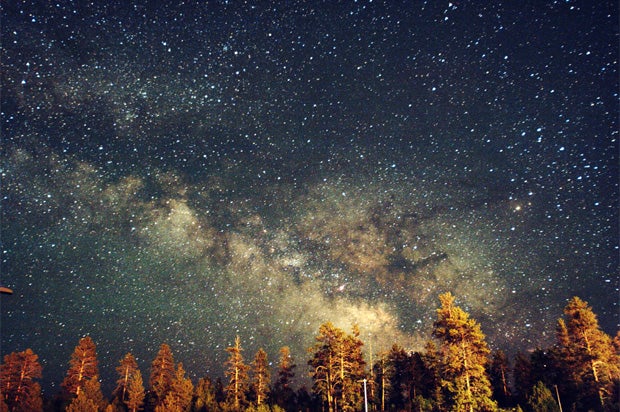Let’s go rogue
ListenNot all planets orbit the stars from which they derived, and it’s now thought that some of these ‘free agents’ or ‘rogue planets’ could develop on their own. The newly discovered planet “Kepler-78B” is earth-like in size but it orbits its star in just 8.5 hours – and temperatures at the surface range from 3,680 and 5,120 degrees F – hot enough to melt iron! There are plenty of planets to be seen in the night sky this week.
August 26, 2013
[Dave Heller] A hot Earth doesn’t necessarily have anything to do with global warming, and we needn’t enter the debate over climate change to prove it. Here to present the incontrovertible evidence is Derrick Pitts, chief astronomer at the Franklin Institute. Derrick, I for one am a skeptic — how can there be a hot Earth?
[Derrick Pitts] No problem, Dave. Let’s take a look around the rest of the galaxy and see what’s out there to be found. If we look at the 932 confirmed objects that we now see as planets orbiting other stars, we discovered that there are plenty of possibilities what can go on with these in terms of their relationship to their own sun. In this particular case, we’re talking about planet Kepler-78B, which looks like what we call a “hot Earth” — an Earth-sized planet whose temperatures naturally are somewhere between 3600 degrees and 5100 degrees Fahrenheit, mostly because it’s way too close to its star.
Is it also because it has an atmosphere?
We aren’t even that far along with the atmosphere, we’re just talking about the planet’s surface temperature itself. Oh it has global warming all right, but it’s pretty universal for that planet and pretty natural because that’s its normal state in its distance from its parent star.
So if it’s that close to its star, I suspect its year is much shorter than ours?
I think you’re right about that. In fact, it is pretty short — it’s only eight and a half hours. Wow. Can you imagine that? Only eight and a half hours. Now that’s compared to our planet’s one year — 365 days it takes to go around its star once. And it’s not the shortest one. The shortest is an unconfirmed 4.3 hours. That’s pretty mind-blowing and certainly mind-spinning to think that a planet can orbit in just 8 hours.
-

An artist imagining of a Kepler planet. Credit: Wikipedia.
Though of these 900+ planets that have been discovered, is this the one that’s most Earth-like in terms of its size?
Not even that. It’s close to the size of Earth, meaning that’s it’s not the size of the typical kinds of planets that are discovered, which are called “hot Jupiters”. These are planets that are about the size of our solar system’s planet Jupiter — 88,000 miles in diameter, or 100,000 miles in diameter, compared to the Earth which is only 8,000 miles in diameter. But they’re called hot Jupiters because they are unbelievably close to their star, so they’re very, very hot too. Not this hot. Now in terms of being Earth-like, it’s relative because it’s approaching the size of Earth, but it’s nothing like Earth at all. And whenever we hear this term “Earth-like”, we’re trying to refer to something that might be within what’s called the Goldilocks Zone — not too hot, not too cold, just right. But this isn’t even close except in size, because obviously that temperature — 3600 degrees to 5100 degrees — is so hot that iron exists as a liquid on that surface, if it does exist there.
Let’s review the family tree — stars spawn planets, right?
Uh, yes… to some degree. Astronomers are now figuring out though that there may be something else going on. We’ve spoken before about the idea of what are called rogue planets. These are interstellar planets — planets that exist in a space where there are no stars not associated with planets. As we know, planets are typically spun out of the same material that stars are made from, it’s just that the planetary material is so much heavier it falls outside of the star and turns into the rocky planets and the gassy planets that we know. Swedish astronomers have determined that it might be possible for these interstellar rogue planets to be developed from the gases found in a stellar nebula — a star that has already exploded — oftentimes has these very tiny little globules of material that are somewhat starlike, but not big enough to become full stars. So if they have just enough material in the right conditions, they may create what we know of as Brown Dwarfs. These are very, very small, very, very low temperature stars — so low they don’t even radiate light. You can only detect them by looking for their heat signature. Well let’s imagine that a Brown Dwarf doesn’t have enough material to even become that. It’s light enough to be blasted out of the nebula by the parent star, and perhaps begin to collapse enough to create these planet-like objects that seem to be in between stars.
Would their composition be dramatically different than the planets in our solar system?
We’re not too far down the pipe to determine that yet, we simply have an idea for the possibility of a process that might produce these. More work has to be done not only to find more of these things, but figure out a way to analyze them so that we can gather data that will tell us more about their composition.
Let’s go with what we know — what’s available in the night sky this week?
Low on the western side of the sky we still find Venus, down really low, and Saturn’s creeping down towards it. The planet Saturn with its beautiful rings now sets by 10 p.m. so we know that in the next few weeks it’s going to disappear from our evening sky. So that will leave us with just Venus, down very low. But we can still catch some planets around in the morning sky. We can still see Jupiter, nice and bright, high above the eastern horizon, about 45 minutes before sunrise. And down below it toward the horizon we find the planet Mars is there also. So we have some planets in the evening, some planets in the morning, but because it’s such a wonderful time to be out observing just before the end of summer, it’s a great time to go out and see the Milky Way as it stretches across the sky from the north-northeast down to the south-southwest. A pair of binoculars will really enhance your view of all the stars, and some star clusters that you’ll see buried in all the billions of stars of our galaxy.
-

154-panel Widefield Milky Way Panorama. Photo by Flickr user s58y
-

Milky Way. Photo by Flickr user Mike Durkin
WHYY is your source for fact-based, in-depth journalism and information. As a nonprofit organization, we rely on financial support from readers like you. Please give today.




